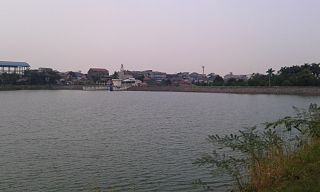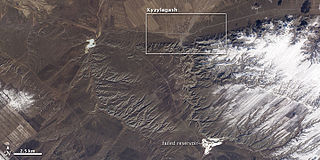Related Research Articles

The Johnstown Flood, sometimes referred to locally as Great Flood of 1889, occurred on Friday, May 31, 1889, after the catastrophic failure of the South Fork Dam, located on the south fork of the Little Conemaugh River, 14 miles (23 km) upstream of the town of Johnstown, Pennsylvania, United States. The dam ruptured after several days of extremely heavy rainfall, releasing 14.55 million cubic meters of water. With a volumetric flow rate that temporarily equaled the average flow rate of the Mississippi River, the flood killed 2,208 people and accounted for US$17,000,000 in damage.

A cloudburst is an extreme amount of precipitation in a short period of time, sometimes accompanied by hail and thunder, which is capable of creating flood conditions. Cloudbursts can quickly dump large amounts of water, e.g. 25 mm of the precipitation corresponds to 25,000 metric tons per square kilometre. However, cloudbursts are infrequent as they occur only via orographic lift or occasionally when a warm air parcel mixes with cooler air, resulting in sudden condensation. At times, a large amount of runoff from higher elevations is mistakenly conflated with a cloudburst. The term "cloudburst" arose from the notion that clouds were akin to water balloons and could burst, resulting in rapid precipitation. Though this idea has since been disproven, the term remains in use.

Situ Gintung is an artificial lake near to the town of Cirendeu in the city of South Tangerang, Indonesia. It was formed by a dam up to 16 m (52 ft) high which was built by Dutch colonial authorities in 1933. The dam failed on 27 March 2009, draining the lake, with resulting floods killing at least 100 people.

The 2009 Messina floods and mudslides occurred in Sicily on the night of 1–2 October, mainly along the Ionian coast in the Province of Messina. They also affected other parts of northeastern Sicily and killed a total of at least 31 people, some of whom were swept out to sea. More than 400 people were left homeless, as many houses collapsed.

The Kyzyl-Agash Dam failure, occurred in a dam located outside the village of Kyzyl-Agash, Jetisu Region, Kazakhstan. On 11 March 2010, the dam burst, flooding the village. At least 43 people were killed, 211 people were injured, and over 1000 evacuated from the village.

Maai Mahiu is a town in Kenya's Nakuru County. The name means "hot water" in native Kikuyu, but another derivative could be "me'imayu", meaning impassable in Maasai.

The global weather activity of 2010 includes major meteorological events in the Earth's atmosphere during the year, including winter storms, hailstorms, out of season monsoon rain storms, extratropical cyclones, gales, microbursts, flooding, rainstorms, tropical cyclones, and other severe weather events.

The 2010 China floods began in early May 2010. Three hundred and ninety-two people died, and a further 232 people were reported missing as of June 30, 2010, including 57 people in a landslide in Guizhou. Fifty-three of the deaths occurred from the flooding and landslides between May 31 and June 3, and 266 deaths occurred between June 13 and June 29. Four hundred and twenty four people were killed by the end of June, including 42 from the Guizhou landslide; 277 more were killed and 147 were missing in the first two weeks of July, bringing the death toll as of August 5 to 1,072. A landslide in early August in Gansu killed at least 1,471 people and left 294 missing. In total, the flooding and landslides killed at least 3,185 people in China by August 31. More than 230 million people in 28 provinces, municipalities, and regions, especially the southern and central provinces and regions of Zhejiang, Fujian, Jiangxi, Hubei, Hunan, Guangdong, Guangxi, Chongqing Municipality, Gansu, Sichuan, and Guizhou, and the northeastern province of Jilin were affected, while at least 4.66 million people were evacuated because of the risk of flooding and landslides in the latter half of June. By early August, over 12 million people were evacuated, and that number rose to 15.2 million by August 31.

The 2010 Northeastern Brazil rains caused widespread flooding in the second half of June 2010. The flooding mainly hit Alagoas and Pernambuco, where entire villages were carried away, killing dozens and causing hundreds to disappear.
The 2010 Romanian floods were the result of an extreme weather event that struck Romania in late June 2010. Currently, at least 21 people died. The north-east of the country, especially Suceava County was most affected. Also affected was the Chernivtsi Oblast in neighbouring Ukraine.

The 2010 Ladakh floods occurred on 6 August 2010 across a large part of Ladakh, then part of the state of Jammu and Kashmir. 71 towns and villages were damaged, including the main town in the area, Leh. At least 255 people are reported to have died, six of whom were foreign tourists, after a cloudburst and heavy overnight rains triggered flash floods, mudflows, and debris flows. 200 people were reported missing in the initial aftermath of the storm, and thousands more were rendered homeless after the flooding caused extensive damage to property and infrastructure. Overall, 9000 people were directly affected by the event.

Following heavy rain in July and August 2017, the Indian state of West Bengal was affected by severe flooding. The floods were reported to have caused 50 deaths since 1 August and 8 deaths in the neighbouring state of Jharkhand.
Events in the year 2018 in Kenya.
The Patel Milmet Dam was a privately owned embankment dam located near the township of Solai, Nakuru County, in Kenya's Rift Valley. The dam burst amid heavy rains on 9 May 2018, killing at least 48 people.
The 2018 East Africa Floods were a natural disaster in Kenya, Ethiopia, Uganda, Rwanda, Somalia, Djibouti, and Burundi affecting millions of people. They began when excessive rains began falling in March 2018 following a year of severe drought, leading to massive flooding, landslides, and the failure and overflow of several dams. Record rainfall was recorded in several areas, surpassing various records set during the 1950s and during the 1997–98 El Niño event. Nearly 500 people have lost their lives while hundreds of thousands of others have been displaced.
In June 2021, the flood in Melamchi River caused damage in the Melamchi Bazar in Sindhupalchowk District of Nepal killing several locals and some foreigners
Events in the year 2024 in Kenya.
Starting 18 April 2024, floods hit Kenya, affecting people in 33 of the 47 counties.
References
- ↑ "Kenya flooding: Around 50 killed in villages near Mai Mahiu town". www.bbc.com. 29 April 2024. Archived from the original on 29 April 2024. Retrieved 4 May 2024.
- 1 2 3 "Flash floods, landslide kill at least 45 in central Kenya". Reuters . Archived from the original on 29 April 2024. Retrieved 29 April 2024.
- 1 2 "At least 45 people die in western Kenya as floodwaters sweep away houses and cars". AP News. 29 April 2024. Archived from the original on 29 April 2024. Retrieved 1 May 2024.
- 1 2 3 4 Usher, Barbara Plett; Wafula, Ian (1 May 2024). "Kenya flooding: Around 50 killed in villages near Mai Mahiu town". BBC News. Archived from the original on 29 April 2024. Retrieved 4 May 2024.
- ↑ "'Don't know how many under mud': 45 killed as dam bursts in flood-hit Kenya". South China Morning Post. 29 April 2024. Archived from the original on 29 April 2024. Retrieved 29 April 2024.
- ↑ "With shovels, rescuers search for rising number of Kenya flood victims". Reuters. 30 April 2024. Retrieved 1 May 2024.
- ↑ "Kenya dam burst: Around 50 killed in villages near Mai Mahiu town". 29 April 2024. Archived from the original on 29 April 2024. Retrieved 29 April 2024.
- ↑ "Scores killed in Kenya after dam bursts following weeks of heavy flooding". Agence France-Presse. 29 April 2024. Archived from the original on 29 April 2024. Retrieved 29 April 2024.
- 1 2 "At least 40 people die in western Kenya after heavy rains cause a dam collapse". Associated Press. PBS News. 29 April 2024. Archived from the original on 1 May 2024. Retrieved 1 May 2024.
- 1 2 "Dozens dead after dam bursts amid torrential rain in Kenya". Agence France-Presse. The Guardian. 29 April 2024. Archived from the original on 30 April 2024. Retrieved 1 May 2024.